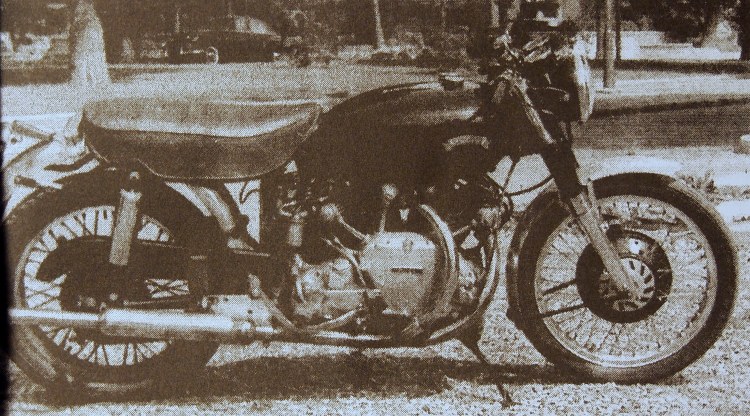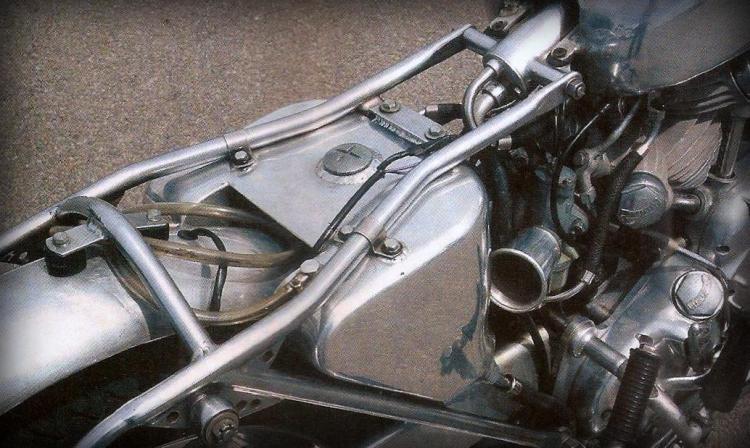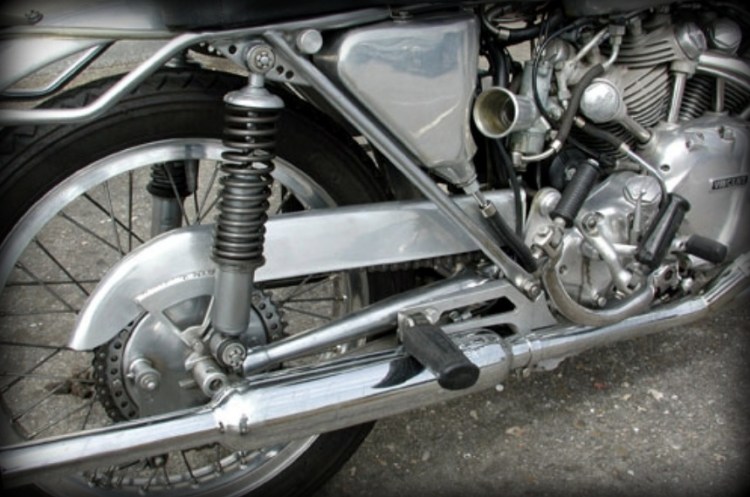Among all the names that are often associated to the Vincent brand, only a few have been close enough to carve the Vincent legend, and no one will dispute that George Brown is one of these. From 1934 to 1951, George was leading the Vincent experimental shop, so his story is intimately associated with Gunga Din (1), the laboratory bike used for records, racing and, of course, the development of performance parts that lead to the Black Shadow and Lightning specifications.
As soon as 1951, George was already aware of the limitations that the cantilever and the Girdraulic suspensions were having on Gunga Din overall performance. He had a few ideas to improve the bike handing: modern suspensions similar to the contemporaneous 500cc racers (Manx and G50); however for marketing reasons, Philip Vincent would not let him do it. Frustration was adding up, and one event might have triggered George’s decision to leave the factory after 17 years: at Goodwood meeting in 1951, George won the 1000cc race at 82.84mph while Geoff Duke won the 500cc race at 87.08mph on a 500 Manx (2).
It was the last outing on Gunga Din as George and his brother Cliff opened a motorcycle workshop in High Street, Stevenage. But soon, the speed demon knocked at the door and for £5, they bought a burnt-out Rapide to build their own racer that got nicknamed “Nero” because of its fate. Nero was designed for hill climbs and sprints and of course, used the conventional suspensions that George had in mind. On alcohol and nitro-methane full-blends, Nero was pulling 85 BHP, and success in racing did not take long to echo overseas; but honestly, who at that time was more qualified than George Brown to leverage the developments made on Gunga Din into his own Vincent racer?
On the other side of the Channel, a Frenchman named Marc Bellon, heard these echoes. Marc was the owner of a Rapide that had a serious propensity to wobble at high speed. Thus, when one of these road rodeos ended in a crash, fortunately minor for him and his bike, Marc connected the dots with Nero architecture, convinced that such modification will sort out the bike issues. Motivated, he contacted George Brown by Telegram in September ‘58 and showed up later with his Rapide at Brown’s shop to persuade him to make a street Nero for him.
About a year later, Marc came back to pick up his bike and, as you could expect, the result was close to Brown’s racer. The all-front end had been replaced with an AJS 7R telescopic fork and conical brake, both wheels being wired with 19in aluminum rims. On the back end, a tubular sub-frame supporting the Velocette-based swinging arm, and Woodhead Munroe shocks were replacing the Vincent RFM (3), while the UFM (4) was preserved in the operation. In this configuration, the bike was significantly lighter than a stock Rapide (5). Two more Nero Replicas were subsequently built on this model by George Brown: one for a Scottish physician and the other one for a merchant of Eastbourne, all 3 bikes were built with stock engines. Although, demand was coming steadily, George never had the time to accept new orders, maybe because he was already moving into his new project: designing and building Super Nero.
Back in France, Marc covered 10,000 miles before he was called on duty in the Algerian events (6). His friend, Marc Souvrain, was entrusted to take care of it, but when Marc was discharged, he found his bike in a non-running poor state of repair in which it remained for about 20 years. From the mid-80s, started a long process of restoration, long because Mark also wanted to improve the functionalities and the look of his bike: his vision was a combination of unpainted surfaces made of polished aluminum and chrome-plated parts.
The engine was sent to Herve Mocard, who rebuilt it completely with Mahle pistons, MkII cams, Alton generator and ported heads to fit the 30 mm concentric carburetors. The main structural change was the replacement of the Vincent UFM by a custom-made backbone consisting of a large diameter tube to which a solid billet steering head is bolted. Eventually, Francois Grosset had the mission to put all these parts together and not only make the bike functional, but also meet Marc’s objectives in terms of finishing and details. On that perspective, there are a few points that worths a mention: the “Nero style” aluminum tank, the horse-shoe aluminum oil tank fitting the rear frame correctly (7), and various interesting parts made of aluminum such this rear chain case or headlamp and footrest brackets. Finally, a lightweight Yamaha clutch, a Grosset electric start, a Feridax seat and a 5” shadow clock along with a Smith rev counter were adapted to the bike by Francois.
The restoration process completed in 1998, more than 35 years after Marc found his bike broken in crates. Was he satisfied with the result? You bet he was! This French Nero is indeed incredible in quality of the execution and is also extremely well balanced in its proportions. The bike is even lighter at 160 kg (353 lbs) and handles extremely well with its new UFM. Marc has enjoyed riding his Nero until 2009, date it was sold to a customer it in the UK.
Philippe Guyony © 2014






Picture © Michel Cottereau




A big thanks to the French section of the V.O.C. who helped me to assemble this documentation, particularly Serge Vollard (a.k.a Raspoutine), Jean Pirot, Francois Grosset and Dominique Malcor.
(1) see Gunga Din story: http://wp.me/p4cm0Z-kR
(2) According Charlie Rous, Classic Racer Winter 1990
(3) The RFM is acronym for Rear Frame Member
(4) The UFM is acronym for Upper Frame Member, containing the engine oil
(5) Moto Revue #1496 tells about 50 kg (110 lbs), but this seems questionable
(6) These events lead to the independency of the Algeria, July 5, 1962.
(7) Originally Marc wanted to make the new UFM functional as the Vincent design. However down the road, he decided to add this Aluminum oil tank that fits perfectly the bike and thus converted the top tube as a drainable catch tank for the engine breather.
Sources: If you want more information about this bike you can try to find
– Classic Bike September 2002 (story Mike Duckworth)
– Classic Racer Winter 1990 (story Charlie Rous)
– Moto Revue #1496 06/19/1960 (story Marc Souvrain)
– Loup Garreau from VOC France #5 December 1998 (story Jean Pirot)
http://www.bikeexif.com/vincent-motorcycle-2
http://en.wikipedia.org/wiki/George_Brown_(motorcycle_racer)
http://www.myvincent.co.uk/people/george_brown.php

Thanks for the excellent article. I am looking for the contact of Herve Mocard who rebuilt the engine? Best regards